GEOGRAPHIC EXTREMES SOCIETY
AUSTRALIAN RECORDS
Lakes
Australia’s vast range of fascinating lake diversity, whose size, volume, pH and salinity warrant our examination for extremes.
Largest of Australia’s lakes
The greatest lakes in terms of size are in the interior of the continent. As you’d expect from an arid country, they are relatively dry for prolonged periods, with the vast majority being salt lakes or claypans.
If we’re looking for Australia’s largest lake by surface area, the title belongs to Lake Eyre, at 9,500 km2. Lake Eyre is ranked the third largest of the world’s terminal lakes, which are those lakes that don’t empty to the sea. If we were to make a list all of the world’s lakes by the size of surface area, Lake Eyre, even when full, would be lucky to make the Top 20.
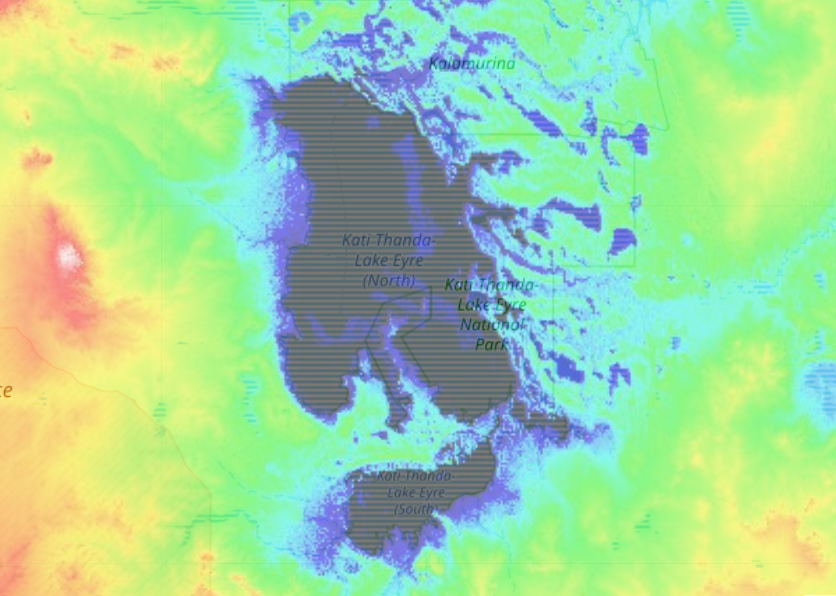
Lake Eyre. Largest Lake In Australia. Image: Topographicmaps.com
The geological record shows that in the past an immense lake, often referred to as Lake Dieri, was once present in this area, encompassing the flooded Lake Eyre and Lake Callabonna, Lake Gregory, Lake Blanche and Lake Frome systems. This huge inland sea was probably last full around 60,000 years ago when the first humans were making landfall in Australia.

Lake Dieri 15,000 years ago. Image: Webb 2009
This estimated 100,000 km2 inland sea was only surpassed in the past ice ages by Lake Carpentaria. This 150,000 km2 sea formed in the Gulf of Carpentaria basin when sea levels retreated allowing Cape York Peninsula and the Northern Territories, Top End, to join with southern New Guinea.
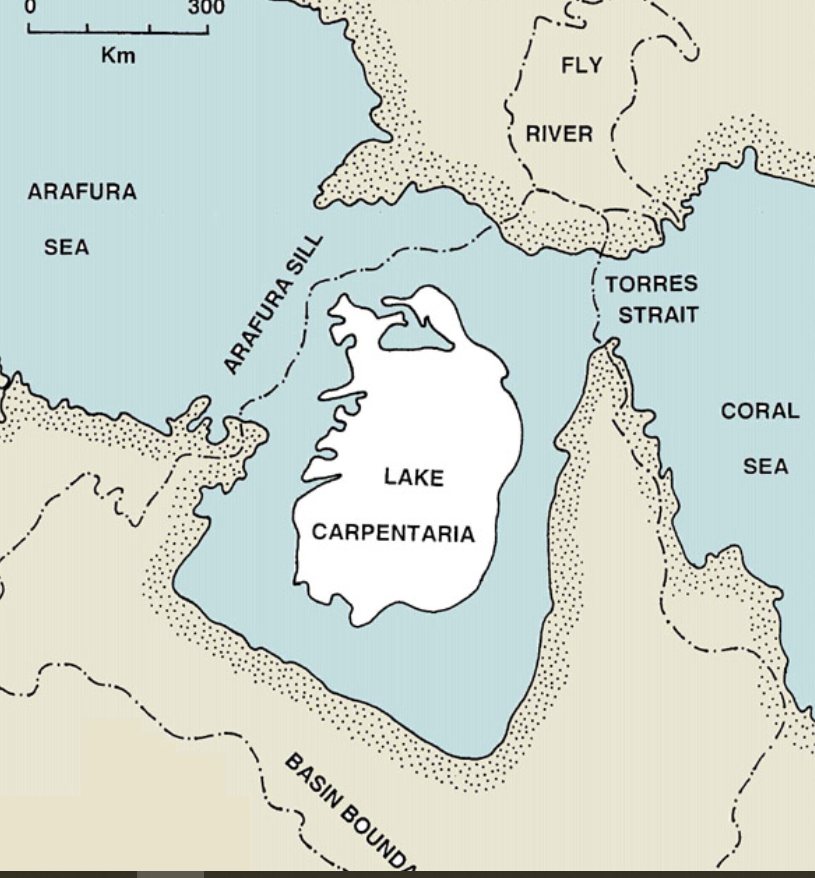
Lake Carpentaria- Largest lake in Pleistocene Australia. Image: Hermon Slade Foundation
Largest man-made lake in Australia
Nobody can dispute the immense size of the Ord River Dam, better known as Lake Argyle, in the East Kimberley of Western Australia. The surface area of the lake is 703 km2, which I have judged as the largest man-made reservoir in Australia, even if only in surface area.
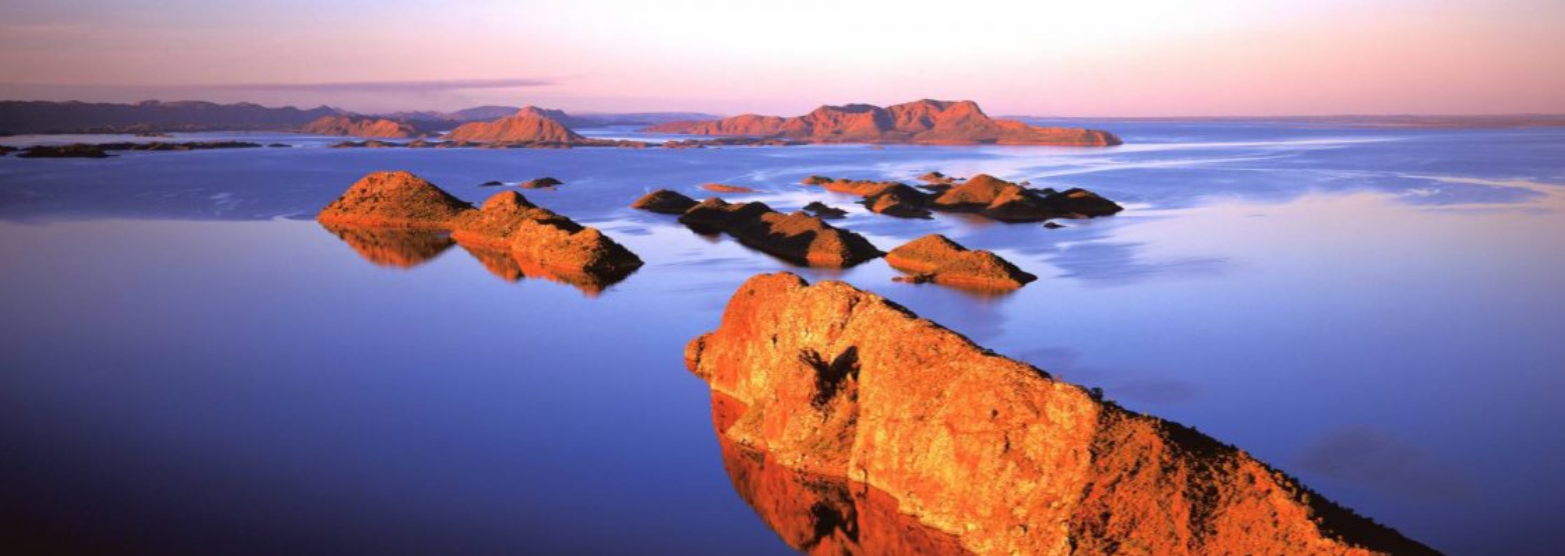
Lake Argyle. Largest man-made lake in Australia. Image: Lakeargyle.com
Contentiously, many people regard the hydro-electric dams in Tasmania as larger than the Ord River Dam. The Gordon Dam in Tasmania’s Southwest Wilderness area is only 40% of the surface area of Lake Argyle, yet it holds a far greater amount of water. Lake Argyle holds 10.7 km3 of water, while the smaller Lake Gordon holds 25% more water at 12.7km3. The reason some consider this man-made water body a larger lake by surface area is due to the McPartlan Pass Canal joins Lake Gordon to Lake Peddar. The combined surface area of Lake Peddar and Lake Gordon surpasses that of Lake Argyle, but the fact is, the McPartlan Pass Canal is a regulated channel and not a free-flowing canal between the two lakes. I, therefore, tend to consider them as two separate lakes. Even though Lake Pedder has a similar surface area to Lake Gordon, it’s a far shallower dam, holding less than a quarter of Lake Gordon’s water.
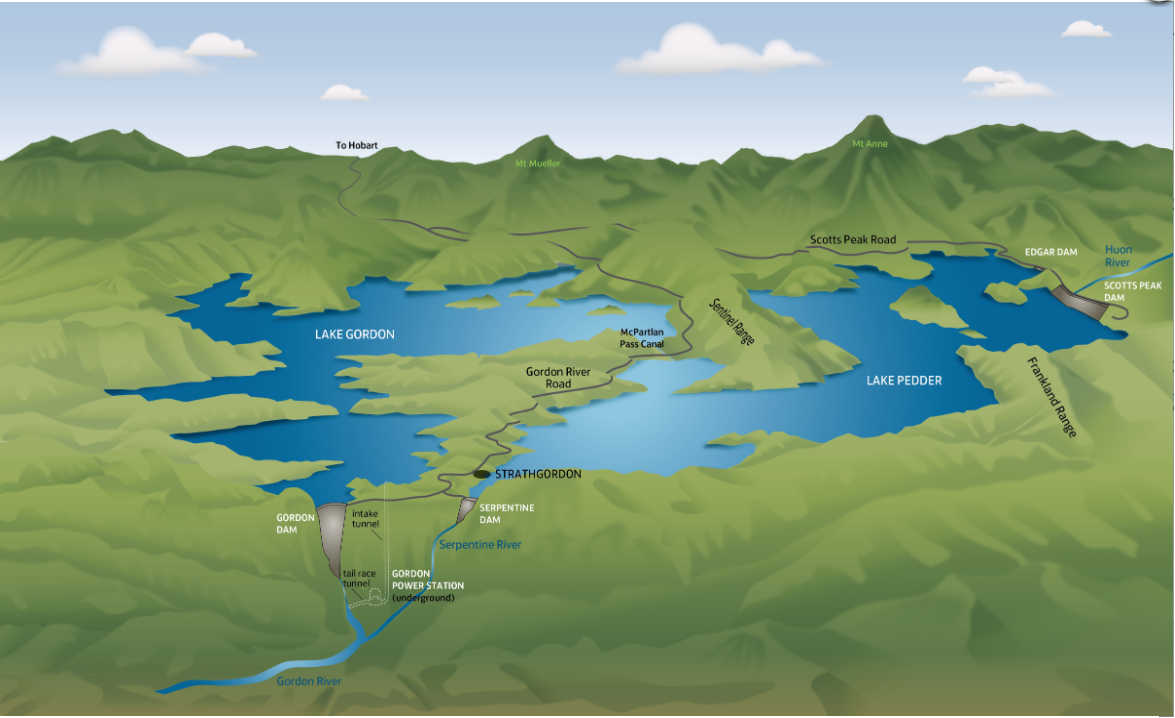
Lake Gordon & Lake Peddar. Lake Gordon is Australia’s largest man-made dam by volume. Image: HEC
Australia’s Deepest Lake
Nearby the Gordon and Lake Pedder dams, Lake St Clair, which at 174 metres is Australia’s deepest lake, was also harnessed to provide hydropower. Lake St Clair forms the headwaters of Hobart’s Derwent River and is also renowned as being the terminus for the famous Overland Track which begins at 157-metre deep Dove Lake at the foot of Cradle Mountain.

Lake St Clair. Australia’s deepest lake. Image: Joe Shemesh
Australia’s Highest Lake
Australia’s highest lake, the small glacial tarn of Lake Cootapatamba, which sits at 2,048 metres above sea level.

Lake Cootapatamba. Australia’s highest lake. Image: Wikimedia commons
Perched Lakes
The magnificent beauty of the perched lakes wins my heart every day. These rare lakes unusually form on sandy substrates. Rather than water quickly permeating through the sands and lost to underground reservoirs, perched lakes accumulate a base of organic matter rich in tannins, known locally as coffee rock, trapping the water to form a lake. Queensland is home to almost half of the world’s perched lakes, and they occur from the dune fields of Cape York, down to Stradbroke Island off the Gold Coast. The largest of all Australia’s permanent perched lakes is Lake Boomanjin on Queensland’s Fraser Island. This 200-hectare lake is permanently stained a tea-colour which contrasts startlingly with the surrounding pure white sands.

Lake Boomanjin. Australia’s largest permanent perched lake Image: Qld Govt
In Western Australia, Toolibin Lake is considered a larger perched lake than Lake Boomanjin, but the surrounding farmland has deprived the lake of clean, fresh water, and it rarely fills. On the rare occasion of flooding into the 300-hectare perched lake, saline water incursions have resulted in deaths of the trees within the lake. It holds water for only a few months of the year and often drying out completely for many years.

Toolibin Lake. Largest perched lake in Australia. Image: Google maps
Crater Lakes or Maars
Arguably some of Australia’s most photographed lakes would have to be the rainforest-framed Lake Eacham, Lake Euramoo, and Lake Barrine on Queensland’s Atherton Tableland. These lakes are the beautiful volcanic crater lakes, known overseas as maars, and contrary to popular belief they aren’t the largest of their type in Australia. These lakes are predominately enclosed systems of freshwater, where rainfall fills extinct or dormant volcanic craters. The environments formed within crater lakes are much like those of mound springs, in which the fish life and other organisms which make it into the lake evolve independently.
We have to look further south to find the largest of all volcanic maars in Australia which is the 552-hectare Lake Purrumbete in the Western District of Victoria. Geologists refer to this region as the Newer Volcanic Province, an area littered with fascinating volcanic features as well as large volcanic maars.

Lake Purrumbete. Largest volcanic Maar in Australia. Image: Lake Purrumbete cottages
Due to the paucity of volcanic activity, Australian maars pale in comparison to others on the northern edge of the Australian Tectonic plate. Maars on the Carstensz Peninsula and Long Island in New Guinea are ten times larger in surface area compared to any in Australia. The 100-kilometre-long Lake Toba on the island of Sumatra in Indonesia is the world’s largest maar with a lake surface of over 113,000 hectares. Lake Toba was estimated to have erupted 75,000 years ago and is thought to be Earth’s greatest volcanic eruption for over 25 million years.
Acid Lakes
Some of these volcanic lakes are considered to be quite acidic; however, some lakes in Australia are so acidic, that the hardest metals will dissolve if left to soak in their waters. Acidic lakes can vary their pH at any time, and mostly this depends on the amount of water entering the lakes which dilutes the acids. Within Australia, acid lakes are found in three provinces: the Yilgarn Craton in Western Australia; the Gawler Craton in South Australia; and the Mallee Province in Victoria.
Gneiss Lake near the small township of Grass Patch has recorded a pH of 1.7 and salinity close to 28%
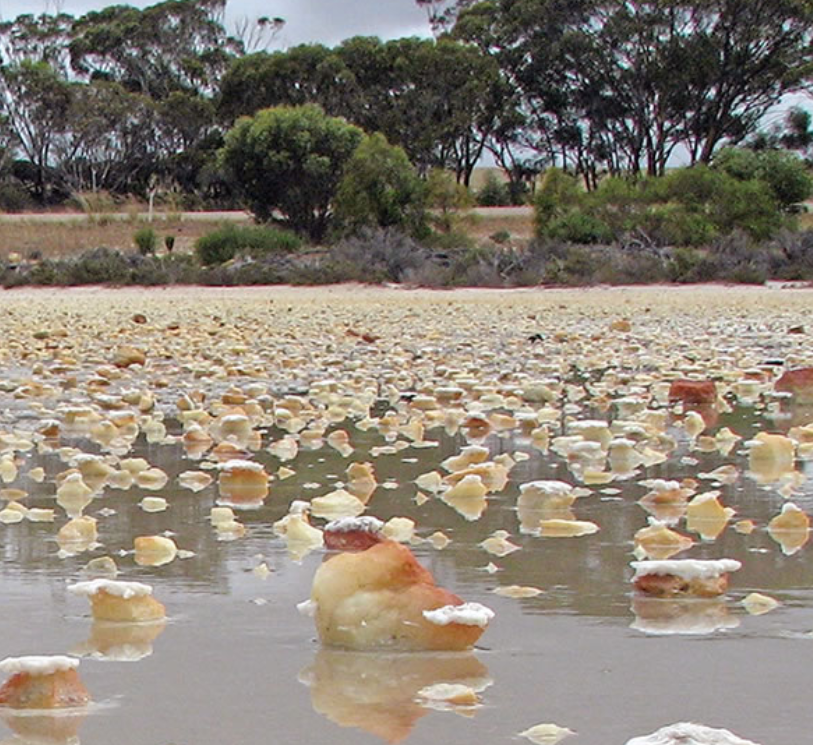
Gneiss Lake. Most acidic lake in Australia. Image: Kathleen Benson
Alkaline Lakes
Australia’s acid lakes are unique, but what about the other end of the pH spectrum? Australian alkaline lakes, also known as soda lakes, are far more common than their acid brine counterparts. Surprisingly, in some circumstances, they can be highly productive environments supporting a wide range of organisms.
The alkaline waters of Lake Callabonna, Lake Frome, Lake Eyre, and Lake Blanche have all significantly contributed to Australia’s fossil record, courtesy of the alkaline environment protecting the skeletons. The alkaline solutions encourage the calcification processes, in contrast to acidic environments where most of the skeletal material is lost. Lake Callabonna in South Australia has provided the best examples, where hundreds of superbly preserved diprotodon, Australia’s extinct giant wombat, fossils remain exposed. Remarkably, the fossil site also included the preservation of their foraging pathways, and so well-preserved are these specimens that one skeleton was found with undigested but fossilised saltbush in its stomach.
Today, the Lake Eyre system has only a mildly alkaline pH. The lakes that give us the extremes of highest alkalinity are Lake Chidnup in Western Australia, and Lake Werowrap in Central Victoria both with the distinction of recording a massive pH of 9.8. [9] Lake Chidnup is located near Ravensthorpe in Western Australia’s south-west. Lithium is being mined for use in alkaline batteries close by Lake Chidnup today.
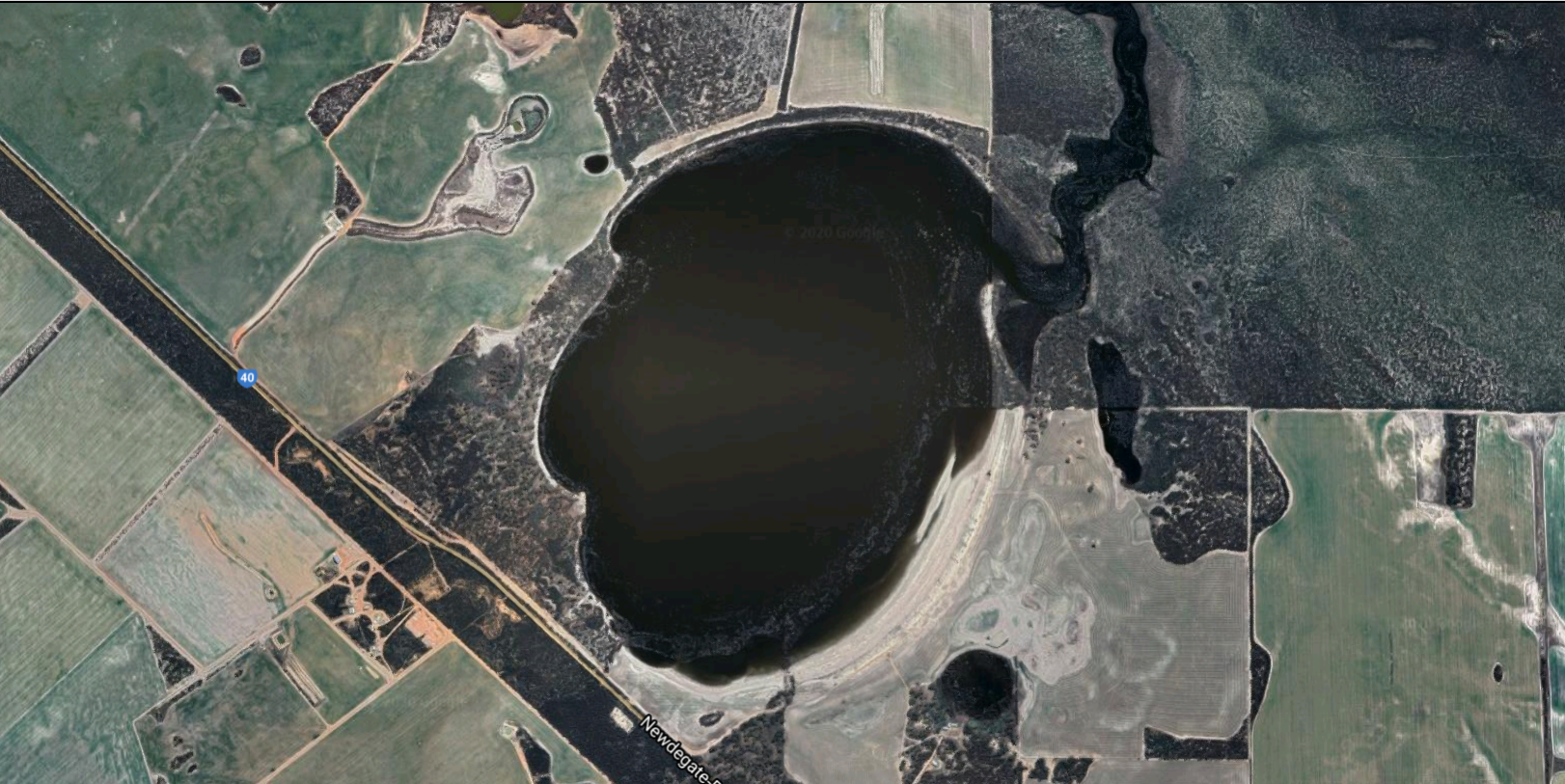
Lake Chidnup. Australia’s most alkaline lake. Image: Google maps
Hypersaline Lakes
Lake Corangamite holds the title of the largest permanent saline lake in Australia. In many ways, it looks and feels like a smaller version of Lake Eyre. Lake Corangamite and all the surrounding lakes of the New Volcanic Province are terminal water bodies of inland drainage basins. Volcanic scoria cones which abound here contributed to the alkalinity of the lakes. These process began five million years ago, lasting until around five thousand years ago. The associated volcanic lava flows were responsible for filling streamlines and damming waterways, stopping rivers from entering the sea, which resulted in the formation of the region’s lakes.
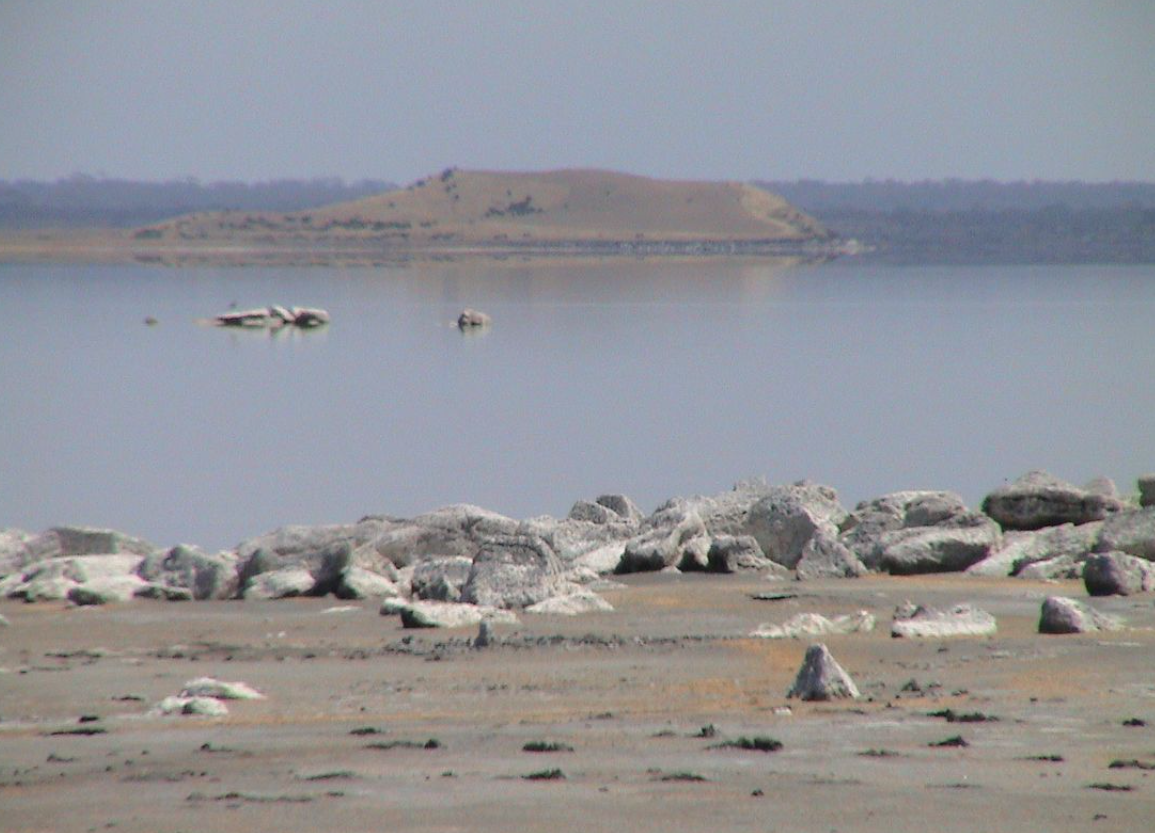
Lake Corangamite. Largest permanent saltwater lake in Australia. Image: Film Victoria
Within this system of lakes, the ones that are most hyper-saline are Lake Beeac and Lake Cundare, both of which have achieved hyper-salinity levels of 350 grams per litre. It’s the highest level of salinity that water can attain before the salt crystallises and can dissolve no further. By way of comparison, seawater has a tenth of the salinity at 35 grams per litre. Hydrologists point the finger at current agricultural practices to contributing to every lake in the Corangamite system undergoing rapid salinity increases, including the previously freshwater Lake Colac.
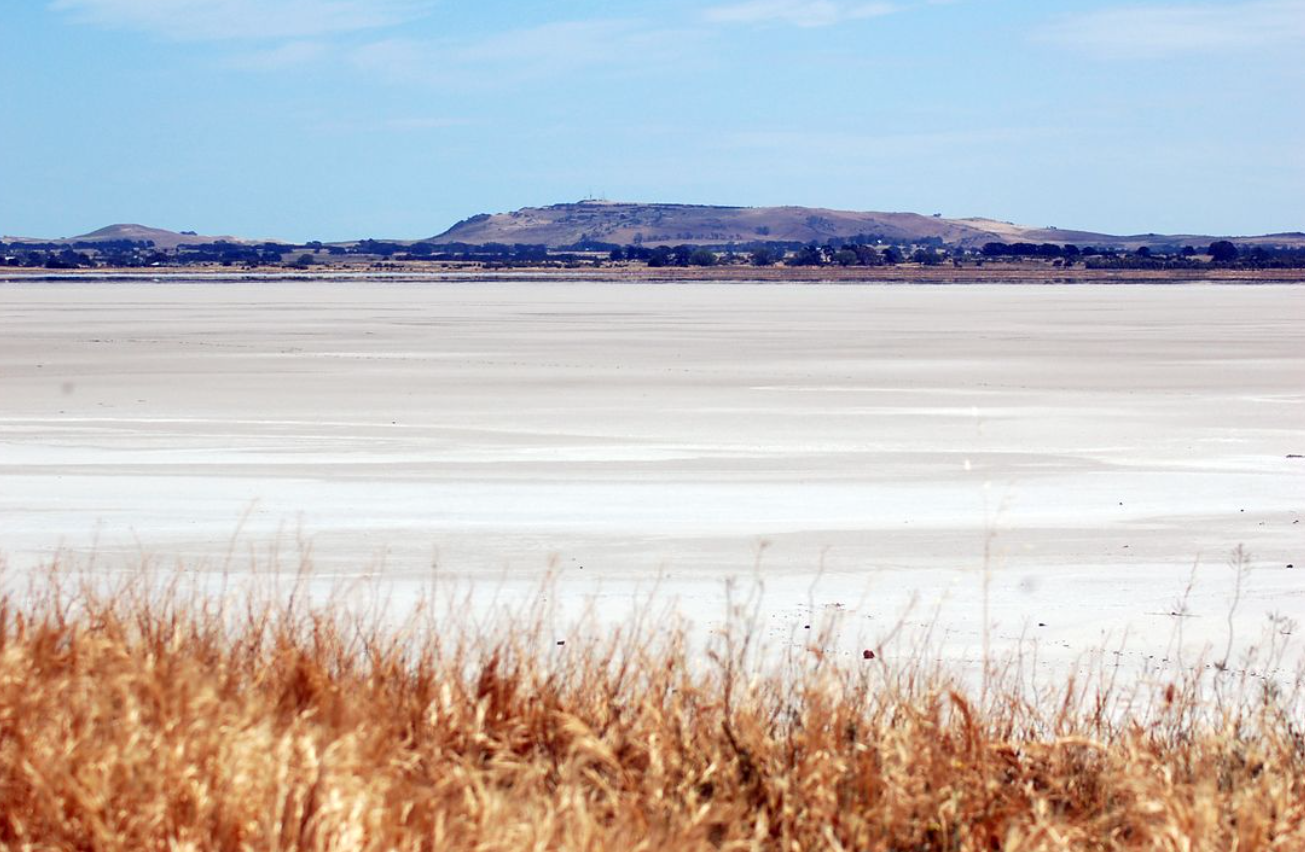
Lake Beeac. Most hypersaline lake in Australia. Image: Film Victoria
Australian Lake Records
GES Record: Largest lake in Australia – Lake Eyre. South Australia. 9,690km2 (Source: Geoscience Australia )
GES Record: Largest man-made reservoir by surface area- Lake Argyle. Western Australia/Northern Territory. 907km2 (Source: Geoscience Australia – note that GA differs in our interpretation of a single lake )
GES Record: Largest man-made reservoir by volume – Lake Gordon. Tasmania. 12.7km3 (12,700 gigalitres) (Source: Geoscience Australia)
GES Record: Deepest lake – Lake St Clair. Tasmania. 274m (Source:Ranger station at Lake St Clair. Pers comm )
GES Record: Highest lake – Lake Cootapatamba. New South Wales. 2,048 metres (Source: West. 1994 )
GES Record: Largest permanent perched lakes – Lake Boomanjin. 190 hectares (Source: fraserisland.net )
GES Record: Largest perched lakes – Lake Toolijin. Fraser Island. Queensland. 300 hectares (Source: Western Australia DPAW )
GES Record: Largest volcanic maar (crater lake) – Lake Purrumbete. Victoria. 5.52km2 (Source: Jordan 2019 )
GES Record: Deepest volcanic maar (crater lake) – Blue Lake. Mt Gambier. South Australia. 75m (Source: Australian Geographic)
GES Record: Most acidic lake – Lake Gneiss. Western Australia. pH 1.7 (Source: K Benison 2007 )
GES Record: Most alkaline lake – Lake Werowrap. Victoria. pH 9.8 (Source: Walker 1973 )
GES Record: Most saline lake – Lake Beeac and Lake Cundare. Victoria (Source: K Hose 2008)
Australian State / Territory Records (source: Geoscience Australia unless noted)
Australian Capital Territory – Lake Burley Griffin 7.2 km2
New South Wales – Lake Garnpung 542 km2
Northern Territory – Lake Amadeus (salt) 1032 km2
Queensland – Lake Yamma Yamma 690 km2 (Source: Qld DES)
South Australia – Lake Eyre (salt) 9690 km2
Tasmania – Lake Gordon 272 km2
Victoria – Lake Corangamite 209 km2
Western Australia – Lake Mackay 3494 km2 (Straddles the NT/WA Border)
The Geographic Extremes Society welcomes any input as to the veracity of these records and we encourage everyone to contribute to these extreme records by contacting us to initiate the discussion
